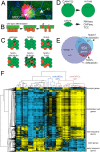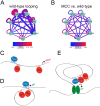Rfx2 Stabilizes Foxj1 Binding at Chromatin Loops to Enable Multiciliated Cell Gene Expression
- PMID: 28103240
- PMCID: PMC5245798
- DOI: 10.1371/journal.pgen.1006538
Rfx2 Stabilizes Foxj1 Binding at Chromatin Loops to Enable Multiciliated Cell Gene Expression
Abstract
Cooperative transcription factor binding at cis-regulatory sites in the genome drives robust eukaryotic gene expression, and many such sites must be coordinated to produce coherent transcriptional programs. The transcriptional program leading to motile cilia formation requires members of the DNA-binding forkhead (Fox) and Rfx transcription factor families and these factors co-localize to cilia gene promoters, but it is not clear how many cilia genes are regulated by these two factors, whether these factors act directly or indirectly, or how these factors act with specificity in the context of a 3-dimensional genome. Here, we use genome-wide approaches to show that cilia genes reside at the boundaries of topological domains and that these areas have low enhancer density. We show that the transcription factors Foxj1 and Rfx2 binding occurs in the promoters of more cilia genes than other known cilia transcription factors and that while Rfx2 binds directly to promoters and enhancers equally, Foxj1 prefers direct binding to enhancers and is stabilized at promoters by Rfx2. Finally, we show that Rfx2 and Foxj1 lie at the anchor endpoints of chromatin loops, suggesting that target genes are activated when Foxj1 bound at distal sites is recruited via a loop created by Rfx2 binding at both sites. We speculate that the primary function of Rfx2 is to stabilize distal enhancers with proximal promoters by operating as a scaffolding factor, bringing key regulatory domains bound by Foxj1 into close physical proximity and enabling coordinated cilia gene expression.
Conflict of interest statement
The authors have declared that no competing interests exist.
Figures






Similar articles
-
Androglobin gene expression patterns and FOXJ1-dependent regulation indicate its functional association with ciliogenesis.J Biol Chem. 2021 Jan-Jun;296:100291. doi: 10.1016/j.jbc.2021.100291. Epub 2021 Jan 13. J Biol Chem. 2021. PMID: 33453283 Free PMC article.
-
Foxn4 promotes gene expression required for the formation of multiple motile cilia.Development. 2016 Dec 15;143(24):4654-4664. doi: 10.1242/dev.143859. Epub 2016 Nov 18. Development. 2016. PMID: 27864379 Free PMC article.
-
The forkhead protein Foxj1 specifies node-like cilia in Xenopus and zebrafish embryos.Nat Genet. 2008 Dec;40(12):1454-60. doi: 10.1038/ng.267. Epub 2008 Nov 16. Nat Genet. 2008. PMID: 19011629 Free PMC article.
-
[Transcriptional control of ciliogenesis in animal development].Biol Aujourdhui. 2012;206(3):205-18. doi: 10.1051/jbio/2012023. Epub 2012 Nov 22. Biol Aujourdhui. 2012. PMID: 23171843 Review. French.
-
Transcriptional control of genes involved in ciliogenesis: a first step in making cilia.Biol Cell. 2010 Jul 9;102(9):499-513. doi: 10.1042/BC20100035. Biol Cell. 2010. PMID: 20690903 Review.
Cited by
-
Bidirectional multiciliated cell extrusion is controlled by Notch-driven basal extrusion and Piezo1-driven apical extrusion.Development. 2023 Sep 1;150(17):dev201612. doi: 10.1242/dev.201612. Epub 2023 Sep 1. Development. 2023. PMID: 37602491 Free PMC article.
-
Mutations in TP73 cause impaired mucociliary clearance and lissencephaly.Am J Hum Genet. 2021 Jul 1;108(7):1318-1329. doi: 10.1016/j.ajhg.2021.05.002. Epub 2021 Jun 1. Am J Hum Genet. 2021. PMID: 34077761 Free PMC article.
-
Interplay of RFX transcription factors 1, 2 and 3 in motile ciliogenesis.Nucleic Acids Res. 2020 Sep 18;48(16):9019-9036. doi: 10.1093/nar/gkaa625. Nucleic Acids Res. 2020. PMID: 32725242 Free PMC article.
-
Astrogliosis and neuroinflammation underlie scoliosis upon cilia dysfunction.Elife. 2024 Oct 10;13:RP96831. doi: 10.7554/eLife.96831. Elife. 2024. PMID: 39388365 Free PMC article.
-
Na+/H+ Exchangers Are Required for the Development and Function of Vertebrate Mucociliary Epithelia.Cells Tissues Organs. 2018;205(5-6):279-292. doi: 10.1159/000492973. Epub 2018 Oct 9. Cells Tissues Organs. 2018. PMID: 30300884 Free PMC article.
References
-
- Gualdi R, Bossard P, Zheng M, Hamada Y, Coleman JR, Zaret KS. Hepatic specification of the gut endoderm in vitro: cell signaling and transcriptional control. Genes Dev. 1996;10: 1670–82. Available: http://www.ncbi.nlm.nih.gov/pubmed/8682297 - PubMed
Publication types
MeSH terms
Substances
Grants and funding
LinkOut - more resources
Full Text Sources
Other Literature Sources
Molecular Biology Databases

